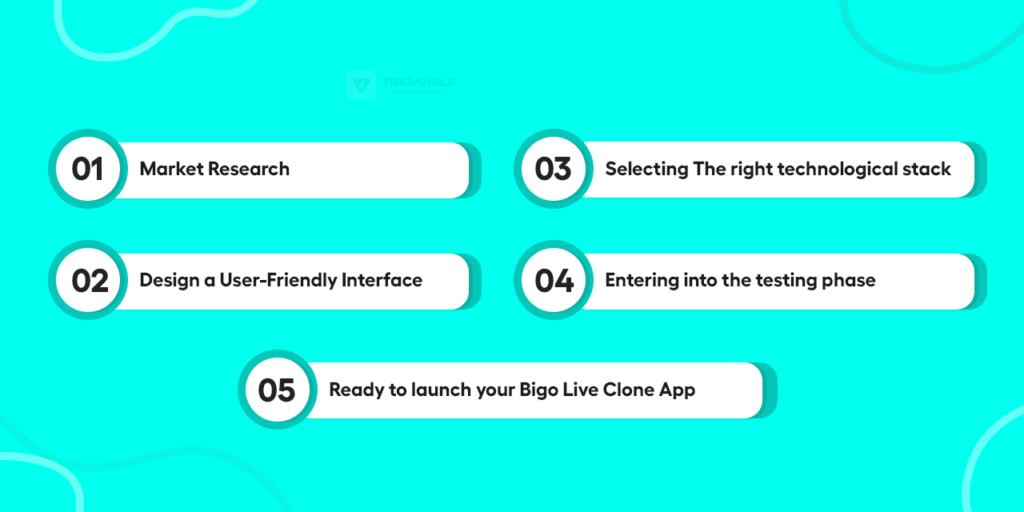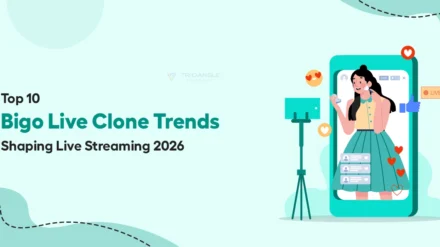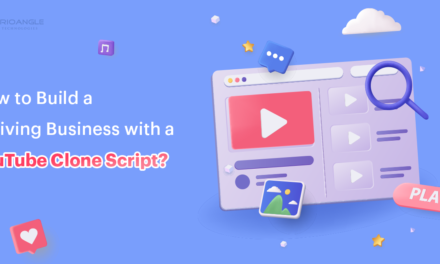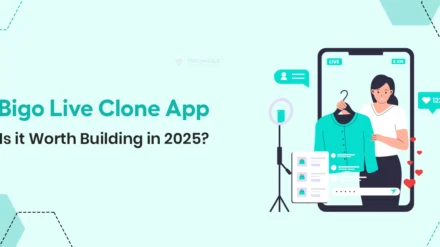Bigo Live clone app is currently a high demand in live short video streaming platforms, particularly in the entertainment, gaming, and social media industries.
The need for real-time content from users, enhanced internet access, and rising smartphone adoption are expected to propel the worldwide live-streaming industry to over $250 billion in 2025.
It has emerged as a model for prospective firms aiming to create comparable platforms because of its monetization features, which include virtual gifting and multi-guest live rooms.
Live streaming services are now essential components of the digital entertainment environment.
These live-streaming clone apps have made it possible for business owners to capitalise on the growing demand from customers looking for real-time channels.
Bigo Live clones are exact duplicates of the original Live streaming apps, which allows you to customize the platform in order to meet your unique business requirements.
This blog guides you on the right path to build a Bigo Live clone app effectively. Come on, let’s explore it.
Understanding The Bigo Live Clone Concept
The Bigo Live clone script is a pre-made solution that mimics the original Bigo Live app features. It enables businesses to create and launch their own video streaming apps in a fraction of the time and expense. But it also enables customization to set the platform apart and make it fit particular target markets or audiences. People who want to get into the live-streaming business fast and take advantage of its rising popularity can easily and affordably build their own distinctive live streaming platforms.
Using a video streaming script saves your time and money on development while utilizing user-requested features and capabilities to launch your short video sharing app swiftly and effectively. To set your platform apart, you can add interactive components and customize it with unique features. Building a feature-rich Bigo Live clone script with a strong backend architecture will enable you to manage growing needs for content delivery, data storage, and user traffic.
Let’s learn the step-by-step guide to building a Bigo Live clone app.
Step-by-Step Guide to Build a Bigo Live Clone App
Creating a Bigo Live clone necessitates a methodical process that involves everything from market research to continuing upkeep. Let us get into the process step by step.

STEP 1: Effective Market Analysis And Planning
It’s crucial to carry out in-depth market research before development. It includes learning about the competitive environment, target audience demographics, user preferences, and new developments in the live-streaming sector. Be clear with your business niche and objectives to reach your destination smoothly by tackling the hurdles. This helps you to receive consistent success and avoid temporary triumphs.
- Before starting to build a Bigo Live clone app, you need a well-designed plan that makes your move perfect.
- Analyzing your competitors helps you set your short video-sharing app apart, and creating user personas guarantees that your feature list satisfies user needs.
- In order to guarantee compliance, just look into local regulations, content moderation guidelines, and platform policies regarding video streaming.
- So, know your competitor first and get to know about their strength and weaknesses, which will help you to improve your bigo live clone performance.
- This tends to beat your competitor and stay ahead in the top position in the market industry.
Identify your target audience and their needs to suit your business needs. Are you aware of how to find your audience? It’s just simple. Just analyze the user behavior and preferences that match your business niche.
So, make sure to research all these actions to get a clear plan for launching your Bigo Live clone app.
STEP 2: Design a User-Friendly Interface
It is essential to design a user interface and user experience that are both aesthetically pleasing and intuitive. Make sure your Bigo Live clone app is simple to use, loads rapidly, and functions without hiccups. Use a sophisticated layout, simple designs, and seamless screen transitions to keep users interested.
Design a wireframe that shows a seamless, understandable user journey from app startup to joining a broadcast or going live. Verify the user engagement tactics, test navigation, and spot usability problems early in the design process with these interactive mockups. Since over 80% of live streaming users access apps via mobile, focus on responsive design. Give priority to touch-friendly controls, optimized video orientation, fast-loading screens, and battery and data-efficient streaming behavior.
Design for varying screen sizes to ensure a seamless experience across iOS & Android devices. Engaging UI components such as interactive conversation, gifting animations, and gamification features, when paired with a seamless user experience, turn passive users into engaged community members. Decrease development costs, prevent rework, and increase user retention right away by investing early in wireframes, prototypes, and mobile-optimized user experience.
It lowers the risks associated with development, speeds up time to market, and builds a competitive live-streaming platform. Create an immersive and engaging short video-sharing app that satisfies users and promotes steady growth.
STEP 3: Select The Right Technological Stack
Selecting the right technological stack for developing your short video-sharing app is not as easy as there are several programming languages. Just get to know the advanced technological stack. Your Bigo Clone app’s performance is significantly impacted by the technology stack you choose.
Use frameworks like React Native or Flutter when creating front-end apps to guarantee seamless cross-platform functionality. Ruby on Rails, Node.js, and Django. JSON is a backend technology that is ideal for real-time communication. It is advised to use NoSQL, MongoDB, and Firebase for databases that store flexible data, and PostgreSQL and MySQL for databases that store transactional data.
Live streaming requires scalable hosting, CDN, and media storage services, which are provided by cloud infrastructure providers like AWS, Google Cloud, or Microsoft Azure. Furthermore, incorporating third-party services for analytics, payment gateways, and push alerts speeds up development while maintaining dependability. Delivering a flawless live streaming experience requires choosing the appropriate stack that fits your business requirements, budget, and scalability objectives.
Delivering a seamless, lag-free experience that users anticipate from a live streaming platform requires a balanced strategy. It makes use of cross-platform frameworks for quicker releases and strong backend technologies that manage real-time streaming. Moreover, incorporating dependable streaming protocols and scalable cloud services guarantees that your business grows as easily as your user base does. By lowering technical debt and speeding up time-to-market, investing in the correct stack up front helps your Bigo Live clone stand out in a crowded market.
STEP 4: Enter The Testing Phase
After the development process, your Bigo Live clone app is tested to make sure all the features and functionality are working properly. To make sure that your Bigo Live clone program offers a smooth, error-free, and safe user experience, testing is essential. This stage necessitates thorough functional, performance, and security testing across numerous devices and network conditions due to the real-time nature of live broadcasting.
To ensure that all features live video streaming, chat, gifting, user registration, and payment processing function as planned, start with functional testing. This involves evaluating the user interface’s responsiveness and consistency in navigating across various operating systems and screen sizes. Performance testing is done to see how the short video-sharing software can manage several live feeds at once without lagging or crashing.
Stress testing and load tests mimic high user traffic to find possible bottlenecks in database performance, server response times, and streaming latency. Because live streaming apps manage private user information and in-app transactions, security testing is especially crucial. Penetration testing, data encryption validation, and making sure that secure authentication procedures are in place to stop fraud and unwanted access are all part of this step.
Furthermore, usability testing with actual users yields insightful input on the elements that encourage user engagement and app intuitiveness. Comprehensive coverage is ensured through the use of both automated and human testing technologies. Lastly, early defect detection through continuous integration and testing during development facilitates a quicker time to market and the production of a reliable, excellent live-streaming app.
STEP 5: Launch Your Short Video-Sharing App
A crucial turning point is reached when your Bigo Live clone app is released, after months of development, testing, and improvement. Careful preparation is necessary for a successful launch in order to guarantee that your software reaches the intended audience and acquires traction at first. To get real-world input and address any last-minute flaws, do a soft launch or beta release with a small user base before launching.
This stage aids in validating monetization flows, such as in-app purchases and gifts, and improving performance under real user load. To increase awareness and downloads, develop a marketing plan that makes use of influencer relationships, social media, and sponsored advertisements. To promote early user involvement and community development, take into account referral schemes and in-app rewards.
After the app launches, keep a tight eye on its analytics to track revenue figures, user behavior, and retention rates. Utilize this information to add new features and upgrades to the app over time. A successful launch lays the groundwork for long-term success by enabling your Bigo Live clone software to build a devoted user base and successfully compete in the ever-changing live-streaming industry.
Summing Up!
As we come to the closure of this blog, it guides the step-by-step procedure to build the best Bigo Live clone app. Creating a Bigo Live clone app is an exciting but challenging process that calls for thorough preparation, wise technological decisions, and a thorough comprehension of your target market. In addition to having real-time video capabilities, your Bigo Live app’s success depends on including features like gifting, live chat, and gamification to create an engaging and emotionally rewarding environment.
In an increasingly competitive industry, a well-executed launch and marketing plan attracts and retains users, while rigorous testing guarantees the app operates dependably under large loads. This detailed guide helps you minimise risks, maximise development time, and create a unique live-streaming platform. Ensure that your Bigo Live clone app will remain relevant and successful long after it is released if it is continuously improved based on analytics and user input.
Start to launch your Bigo Live clone app right now!





